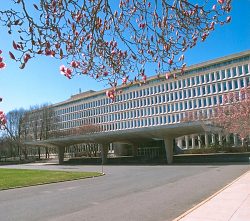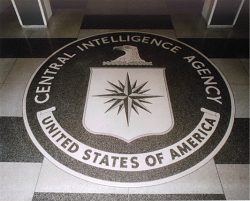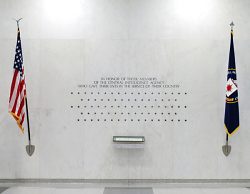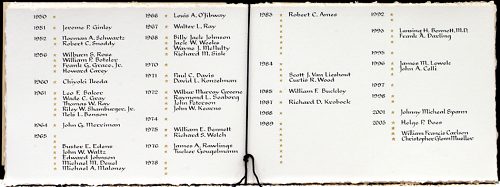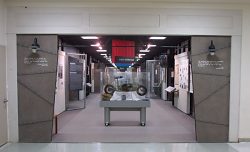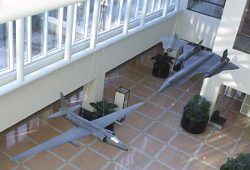CIA - Langley (September 15, 2005)
by Peter W. Merlin
It is impossible to discuss the history of Area 51 without talking about the Central Intelligence Agency (CIA). The CIA created the test facility at Groom Lake, Nevada, in 1955 and sustained it until the Air Force took control of the base in the late 1970s. On 15 September 2005, I had an opportunity to visit the place where it all began: CIA Headquarters in Langley, Virginia.
The month prior to my visit I had completed a project to commemorate the 50th Anniversary of the U-2 in a unique way. To celebrate the Golden Anniversary of the maiden flight and half a century of operational use, I took pieces of the U-2 prototype, encased them in Lucite, and had them flown on a U-2S during a test flight to operational altitudes. I and a colleague distributed these mementos to the people who designed, built and flew the original U-2 and to those organizations who supported development of the aircraft (CIA, AFFTC, etc.). Several of the items were set aside for museums.
Because I arranged to donate one to the CIA, I was invited to tour the Agency's headquarters and see their historic displays. At the same time, I took the opportunity to donate another item: a piece of titanium structure from a Lockheed A-12 (serial no. 60-6928/Article 125). CIA pilot Walter Ray perished in the crash of Article 125 and he is memorialized in the CIA Book of Honor.
I left Alexandria, Virginia, in the morning and took a leisurely drive along the George Washington Parkway. Exiting at McLean I pulled into the south gate and identified myself at the speaker box. The guard instructed me to pull forward, checked my identification and issued me a VIP parking pass. I drove unescorted to the Original Headquarters Building, winding through a lush green forest. The building, in all its 1950s architectural glory, appeared suddenly in a clearing. I parked and walked up a short flight of stairs to the entrance.
Inside the lobby my footsteps echoed on the granite inlaid CIA seal, 16-feet across. Before reaching the guard station, I paused to make a pilgrimage to the CIA Memorial on the north wall. The white marble wall is decorated with 83 engraved black stars, each representing a member of the Agency who perished in the line of duty. A U.S. flag stands to the left and a CIA flag to the right. In the center there is a podium supporting a glass case. Inside the case rests the Book of Honor. The book contains 83 stars, but only 48 names. The others are still classified. Those are reviewed annually for possible declassification. Several of the names in the book are those of U-2 pilots who died at Groom Lake in 1956: Wilburn Rose, Frank Grace and Howard Carey. U-2 pilot Buster Edens, who died at Edwards AFB, California, in 1965 is listed. There are also two A-12 pilots: Walt Ray who died on approach to Area 51 in 1967 and jack Weeks who was lost on a training flight in 1968. On the wall, above the field of stars, are the words: IN HONOR OF THOSE MEMBERS OF THE CENTRAL INTELLIGENCE AGENCY WHO GAVE THEIR LIVES IN THE SERVICE OF THEIR COUNTRY.
After paying my respects, I received my VISITOR badge from the guard and met my escort, the curator of the CIA Museum. We toured a number of historical displays and commemorative sculptures in the lobby and hallways before moving on to the museum's Cold War Display. This section, established by the Center for the Study of Intelligence in 1997, contains over 6,000 clandestine espionage artifacts including numerous tools of tradecraft (dead drops, subminiature cameras, cryptologic equipment, weapons, eavesdropping devices, robotic fish and insects, a mini submarine, and parts of Francis Gary Powers' U-2 that was shot down over Russia in 1960. We also visited the Office of Strategic Services (OSS) historical display. Unfortunately, because of their location, the museum and other areas are not open to the public.
In the New Headquarters Building (NHB), we passed through the atrium in which large models of the U-2, A-12, and D-21 hang from the ceiling. The NHB is a building within a building. The outer structure contains a copper grid to shield against electronic eavesdropping. Inside, curved tunnels further protect conversations from outside listening devices. Most importantly, we visited the gift shop where I loaded up with CIA commemorative goodies and a U-2 model.
We made a final stop at the History Office so I could formally transfer ownership of the A-12 fragment and pick up some unclassified publications. My guide assured me that the CIA is currently devoting its resources to fighting the Global War on Terror. (I have my doubts, however, as they were unable to prevent a Starbucks franchise from opening in their own headquarters building.)
Later, I visited the National Air & Space Museum in Washington, D.C., and saw many interesting historic aircraft and spacecraft. I had a chance to examine Burt Rutan's SpaceShipOne before it is hung from the ceiling of the main gallery. The cockpit is surprisingly sporty with three reclined crew seats. the interior smells of plastic from its composite construction and there is a device (that can only be described as the world's largest Q-Tip) for cleaning condensed moisture off the unreachable forward windows. Some of the fuselage access panels had been removed revealing the interior fuselage structure, truly the acme of the composite worker's art. The engine exhaust cone is rough with blackened propellant residue. Parts of the outer skin were striped with temperature sensitive paint to provide heating data.
All in all, it was a rewarding trip.
© Copyright 1999-, Dreamland Resort. All rights reserved. Copyright Policy Privacy Policy Page last modified 08/04/2018
